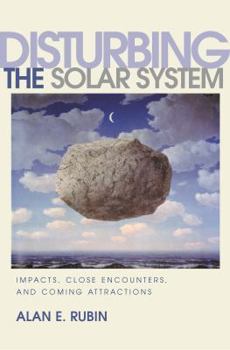Disturbing the Solar System: Impacts, Close Encounters, and Coming Attractions
Select Format
Select Condition 
Book Overview
The solar system has always been a messy place in which gravity wreaks havoc. Moons form, asteroids and comets crash into planets, ice ages commence, and dinosaurs disappear. By describing the... This description may be from another edition of this product.
Format:Hardcover
Language:English
ISBN:0691074747
ISBN13:9780691074740
Release Date:April 2002
Publisher:Princeton University Press
Length:384 Pages
Weight:1.60 lbs.
Dimensions:1.1" x 6.0" x 9.3"
Customer Reviews
3 ratings
A wonderful history of the Earth and the Solar System
Published by Thriftbooks.com User , 21 years ago
This is a marvelous and wide-ranging book. It is written at a level that is accessible to high school students or precocious elementary/middle school students. However, it also satisfies the needs of a senior scientist (namely me) who wants to review current knowledge in this area. The book covers the history of the Solar System, including the formation of the Earth and the origin of the Moon. Current knowledge of asteroids and meteorites, the latter one of the author's specialties, is summarized accurately without boring the reader to tears. The story of giant impacts and mass extinctions, as in the demise of the dinosaurs, is well told. The author carefully explains the evidence that certain meteorites found on Earth were blasted off the Moon and that other meteorites are from Mars. The discussion of the controversy over possible life forms in Martian meteorites is up to the minute. The book concludes with a summary of current thinking about alien life forms and the possibility of life elsewherein the Universe. In the preface, the author states his intention to show that science is an imperfect enterprise. He succeeds admirably, presenting a balanced view of current controversies.
Excellent First Book from Meteoriticist Dr. Rubin
Published by Thriftbooks.com User , 21 years ago
Dr. Alan Rubin's first book covers an extremely diverse (but interrelated) range of topics, including solar system evolution, orbital resonances, mass extinctions, asteroids, meteorites, tektites, craters, volcanism, plate tectonics, magnetic pole reversals, planetary rings, moons, comets, the evolution of life, and even the Drake Equation and the search for extraterrestrial intelligence. No matter how broad your background might be in astronomy, physics, chemistry and biology, you are still likely to find a few topics or theories in this book that you've never been exposed to before.For me, I'd never made the connection that domesticatable animals might be a requirement for a technologically advanced civilization. And while I'd read a number of books (both fiction and non-fiction) suggesting that life might not have evolved if it weren't for our planet's large moon, I had not previously read that the Moon stabilizes the tilt of the earth's axis. I knew about the Moon's role in nutation of the earth's axis, but was not aware that French astronomers had recently performed a computer simulation of what would happen to the earth's axis over time if the Moon were absent. (Gravitational interaction between the planets and earth's equatorial bulge would cause the obliquity of the ecliptic to vary chaotically over relatively small time periods -- millions of years. Such unstable seasons would lead to extreme global climatic fluctuations, making it much more difficult for life to establish itself.)As you might expect, there are many dozens of photographs, diagrams, graphs and illustrations scattered throughout. Indeed, this is the first book I've ever seen that contained pictures of the plaque aboard the Pioneer 10 and 11 spacecraft, the pictogram sent out by the Arecibo dish back in 1974 toward M13, photographs of crater chains on Callisto and the Moon, and a table of all the magnetic pole reversals -- all in one place. It will make a nice reference book whenever I need to find something fast.There is a fairly extensive 18-page glossary covering most of the technical terms in the book, and there are also 10 pages of chapter by chapter references for additional reading. Rubin obviously spent a lot of time putting all of this together.Of course, in any technical book there are bound to be typos and errors, though I found very few. Page 94, for instance, has a confusing phrase "...gravitational resonance between the Moon and the debris disk..." I believe he meant ~earth~ and the debris disk. The most glaring mistake I found is that Figure 11.2 on pg. 164 is misidentified as being a partial eclipse of the earth when it is merely a crescent earth. There are a couple of minor errors in the glossary -- see if you can spot the problems with the definitions of arcsecond and parsec.Overall, the book is well-written in plain English that you don't need a PhD is astrodynamics to understand. I highly recommend it to anyone who wants to expand their appr
Best Science Book In A Long Time
Published by Thriftbooks.com User , 21 years ago
I really enjoyed reading this book and I compliment and commend the writing style of Alan Rubin in "Disturbing The Solar System".It is rare to find books on science written in such readable and understandable prose. It was quite a pleasure to read this book! It is also my opinion that most authors of science related publications could learn something (and probably sell more books!) by observing Mr. Rubin's writing style.




